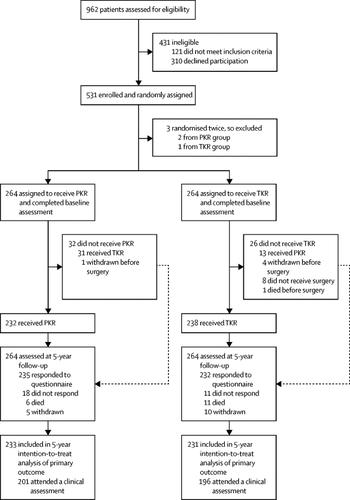Our official English website, www.x-mol.net, welcomes your feedback! (Note: you will need to create a separate account there.)
The clinical and cost-effectiveness of total versus partial knee replacement in patients with medial compartment osteoarthritis (TOPKAT): 5-year outcomes of a randomised controlled trial.
The Lancet ( IF 168.9 ) Pub Date : 2019-07-17 , DOI: 10.1016/s0140-6736(19)31281-4 David J Beard 1 , Loretta J Davies 1 , Jonathan A Cook 2 , Graeme MacLennan 3 , Andrew Price 1 , Seamus Kent 4 , Jemma Hudson 3 , Andrew Carr 1 , Jose Leal 4 , Helen Campbell 4 , Ray Fitzpatrick 4 , Nigel Arden 1 , David Murray 1 , Marion K Campbell 3 ,
The Lancet ( IF 168.9 ) Pub Date : 2019-07-17 , DOI: 10.1016/s0140-6736(19)31281-4 David J Beard 1 , Loretta J Davies 1 , Jonathan A Cook 2 , Graeme MacLennan 3 , Andrew Price 1 , Seamus Kent 4 , Jemma Hudson 3 , Andrew Carr 1 , Jose Leal 4 , Helen Campbell 4 , Ray Fitzpatrick 4 , Nigel Arden 1 , David Murray 1 , Marion K Campbell 3 ,
Affiliation

|
BACKGROUND
Late-stage isolated medial knee osteoarthritis can be treated with total knee replacement (TKR) or partial knee replacement (PKR). There is high variation in treatment choice and little robust evidence to guide selection. The Total or Partial Knee Arthroplasty Trial (TOPKAT) therefore aims to assess the clinical effectiveness and cost-effectiveness of TKR versus PKR in patients with medial compartment osteoarthritis of the knee, and this represents an analysis of the main endpoints at 5 years.
METHODS
Our multicentre, pragmatic randomised controlled trial was done at 27 UK sites. We used a combined expertise-based and equipoise-based approach, in which patients with isolated osteoarthritis of the medial compartment of the knee and who satisfied general requirements for a medial PKR were randomly assigned (1:1) to receive PKR or TKR by surgeons who were either expert in and willing to perform both surgeries or by a surgeon with particular expertise in the allocated procedure. The primary endpoint was the Oxford Knee Score (OKS) 5 years after randomisation in all patients assigned to groups. Health-care costs (in UK 2017 prices) and cost-effectiveness were also assessed. This trial is registered with ISRCTN (ISRCTN03013488) and ClinicalTrials.gov (NCT01352247).
FINDINGS
Between Jan 18, 2010, and Sept 30, 2013, we assessed 962 patients for their eligibility, of whom 431 (45%) patients were excluded (121 [13%] patients did not meet the inclusion criteria and 310 [32%] patients declined to participate) and 528 (55%) patients were randomly assigned to groups. 94% of participants responded to the follow-up survey 5 years after their operation. At the 5-year follow-up, we found no difference in OKS between groups (mean difference 1·04, 95% CI -0·42 to 2·50; p=0·159). In our within-trial cost-effectiveness analysis, we found that PKR was more effective (0·240 additional quality-adjusted life-years, 95% CI 0·046 to 0·434) and less expensive (-£910, 95% CI -1503 to -317) than TKR during the 5 years of follow-up. This finding was a result of slightly better outcomes, lower costs of surgery, and lower follow-up health-care costs with PKR than TKR.
INTERPRETATION
Both TKR and PKR are effective, offer similar clinical outcomes, and result in a similar incidence of re-operations and complications. Based on our clinical findings, and results regarding the lower costs and better cost-effectiveness with PKR during the 5-year study period, we suggest that PKR should be considered the first choice for patients with late-stage isolated medial compartment osteoarthritis.
FUNDING
National Institute for Health Research Health Technology Assessment Programme.
中文翻译:

内侧间室骨关节炎 (TOPKAT) 患者全膝关节置换与部分膝关节置换术的临床和成本效益:一项随机对照试验的 5 年结果。
背景技术晚期孤立性膝关节内侧骨关节炎可以通过全膝关节置换术 (TKR) 或部分膝关节置换术 (PKR) 进行治疗。治疗选择差异很大,几乎没有强有力的证据来指导选择。因此,全膝或部分膝关节置换术试验 (TOPKAT) 旨在评估 TKR 与 PKR 在膝关节内侧间室骨关节炎患者中的临床有效性和成本效益,这是对 5 年主要终点的分析。方法 我们的多中心、实用的随机对照试验在英国的 27 个地点进行。我们使用了基于专业知识和基于平衡的组合方法,其中患有膝关节内侧间室孤立性骨关节炎且满足内侧 PKR 一般要求的患者被随机分配(1:1) 接受 PKR 或 TKR,由精通并愿意进行这两种手术的外科医生或由在分配的程序中具有特殊专业知识的外科医生接受。主要终点是随机分组后 5 年的牛津膝关节评分 (OKS)。还评估了医疗保健成本(以英国 2017 年价格计算)和成本效益。该试验已在 ISRCTN (ISRCTN03013488) 和 ClinicalTrials.gov (NCT01352247) 注册。2010 年 1 月 18 日至 2013 年 9 月 30 日期间,我们评估了 962 名患者的资格,其中 431 名 (45%) 患者被排除在外(121 名 [13%] 名患者不符合纳入标准,310 名 [32%] 名患者不符合纳入标准患者拒绝参与),528 名 (55%) 患者被随机分配到各组。94% 的参与者在手术后 5 年对后续调查做出了回应。在 5 年的随访中,我们发现各组之间的 OKS 没有差异(平均差异 1·04,95% CI -0·42 至 2·50;p=0·159)。在我们的试验内成本效益分析中,我们发现 PKR 更有效(0·240 额外的质量调整生命年,95% CI 0·046 至 0·434)并且更便宜(-910 英镑,95% CI -1503 至 -317) 在 5 年随访期间优于 TKR。这一发现是 PKR 比 TKR 具有更好的结果、更低的手术成本和更低的后续医疗保健成本的结果。解释 TKR 和 PKR 均有效,提供相似的临床结果,并导致相似的再次手术和并发症发生率。根据我们的临床发现,以及在 5 年研究期间使用 PKR 降低成本和提高成本效益的结果,我们建议 PKR 应被视为晚期孤立性内侧间室骨关节炎患者的首选。资助国家卫生研究所卫生技术评估计划。
更新日期:2019-08-30
中文翻译:

内侧间室骨关节炎 (TOPKAT) 患者全膝关节置换与部分膝关节置换术的临床和成本效益:一项随机对照试验的 5 年结果。
背景技术晚期孤立性膝关节内侧骨关节炎可以通过全膝关节置换术 (TKR) 或部分膝关节置换术 (PKR) 进行治疗。治疗选择差异很大,几乎没有强有力的证据来指导选择。因此,全膝或部分膝关节置换术试验 (TOPKAT) 旨在评估 TKR 与 PKR 在膝关节内侧间室骨关节炎患者中的临床有效性和成本效益,这是对 5 年主要终点的分析。方法 我们的多中心、实用的随机对照试验在英国的 27 个地点进行。我们使用了基于专业知识和基于平衡的组合方法,其中患有膝关节内侧间室孤立性骨关节炎且满足内侧 PKR 一般要求的患者被随机分配(1:1) 接受 PKR 或 TKR,由精通并愿意进行这两种手术的外科医生或由在分配的程序中具有特殊专业知识的外科医生接受。主要终点是随机分组后 5 年的牛津膝关节评分 (OKS)。还评估了医疗保健成本(以英国 2017 年价格计算)和成本效益。该试验已在 ISRCTN (ISRCTN03013488) 和 ClinicalTrials.gov (NCT01352247) 注册。2010 年 1 月 18 日至 2013 年 9 月 30 日期间,我们评估了 962 名患者的资格,其中 431 名 (45%) 患者被排除在外(121 名 [13%] 名患者不符合纳入标准,310 名 [32%] 名患者不符合纳入标准患者拒绝参与),528 名 (55%) 患者被随机分配到各组。94% 的参与者在手术后 5 年对后续调查做出了回应。在 5 年的随访中,我们发现各组之间的 OKS 没有差异(平均差异 1·04,95% CI -0·42 至 2·50;p=0·159)。在我们的试验内成本效益分析中,我们发现 PKR 更有效(0·240 额外的质量调整生命年,95% CI 0·046 至 0·434)并且更便宜(-910 英镑,95% CI -1503 至 -317) 在 5 年随访期间优于 TKR。这一发现是 PKR 比 TKR 具有更好的结果、更低的手术成本和更低的后续医疗保健成本的结果。解释 TKR 和 PKR 均有效,提供相似的临床结果,并导致相似的再次手术和并发症发生率。根据我们的临床发现,以及在 5 年研究期间使用 PKR 降低成本和提高成本效益的结果,我们建议 PKR 应被视为晚期孤立性内侧间室骨关节炎患者的首选。资助国家卫生研究所卫生技术评估计划。



























 京公网安备 11010802027423号
京公网安备 11010802027423号